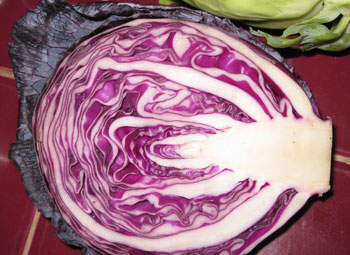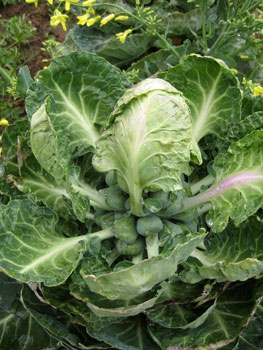Resource Library
Plant of the Week: Brussels Sprouts
The University of Arkansas System Division of Agriculture does not promote, support or recommend plants featured in "Plant of the Week." Please consult your local Extension office for plants suitable for your region.
Plant of the Week
Brussels sprouts
Latin: Brassica oleracea

The hubbub about genetic engineering has died down a bit in the past few years as the two sides of the issue have mostly agreed to disagree. In the two decades since the new technology was introduced, the major impact has been along economic lines, not biological. As a biological template, genetic engineering is hardly new. A look in the vegetable garden at the modern forms of the wild cabbage (Brassica oleracea) that grow there, points this out.
Collectively the descendents of the wild cabbage – originally native along coastal regions of southern Europe and the Mediterranean – are called “cole crops.” This is an Old English name for cabbage that was taken from the Latin word caulis which was what the Romans called the plant they introduced into Brittany during their occupation. Most of the modern variants of the wild cabbage were known to the Romans, indicating that the selection and transformation of this wild plant to the cultivated mainstays we recognize today happened several thousand years ago.
The cole crops consist of eight groups including cabbage, broccoli and cauliflower, mustard, kale, kohlrabi, and Brussels sprouts. A more diverse group of plants arising from a single species is hard to fathom, yet through selection early farmers “engineered” the plants they grew into the diversity of forms now grown.
Kale, with its fleshy leaves held in an open cluster, was probably the first type of cole crop to be domesticated. As a biennial, it produces an open whorl of leaves on a short stem during the cold weather and short day conditions of winter, only sending up an elongated flowering stem when spring arrives. Cabbage probably was the next step in the selection process when a farmer found a plant that held its wax coated leaves in a tight rosette, making it ideal for wintertime storage. Broccoli and cauliflower were selections made for their large fleshy edible flower heads.

Brussels sprouts are, in many ways, a throwback to the original wild form with its elongated stem. In Brussels sprouts, the stem may be 2 feet long, the dwarf type mostly grown today, to as much as 5 feet long with leaves produced up the stem and a topknot of fleshy leaves. At each node, the juncture of the leaf and main stem, a bud forms and enlarges, much like a tiny cabbage head. These sprouts are usually 1 to 2 inches across.
Food historians disagree about the origins of Brussels sprouts. One camp contends that a plant very similar to the modern day vegetable was known to classic Greek scholars, making it a probable candidate for early introduction into northern Europe during the period of Roman expansion. Others contend it was not described until 1587 where it is mentioned in one of the early herbals. It was introduced to Louisiana by the French Acadians who were expelled from the Low Country of Eastern Canada in an early example of ethnic cleansing during the years between 1755 and 1763. Thomas Jefferson grew it at Monticello about 1800, probably from seed obtained from his European friends.
Brussels sprouts seem to be enjoying a comeback today as more health-conscious consumers look for variety in their diets. They contain high amounts of vitamin A, C, folic acid and dietary fiber. And some research indicates they may help protect against colon cancer. Modern breeding techniques have succeeded in reducing the levels of a class of compounds called glucosinolates which are responsible for bitterness and are partly responsible for the increased popularity of the vegetable.
Brussels sprouts are a slow-growing cool weather vegetable that can be grown in any reasonably good garden soil. They can be grown as an early spring crop with plants set out in mid February with sprout production occurring during the early summer or as a fall crop with transplants going to the ground in late July and production occurring until the first hard freeze in early winter. In the southern half of Arkansas, plants will overwinter most years and continue producing throughout the coldest months.
Being a member of the cabbage clan, Brussels sprouts are afflicted by all manner of insects and diseases. The most serious and common of these is the cabbage looper, which can do considerable damage to the foliage, but because the plants are so tough, there will usually be some yield.
By: Gerald Klingaman, retired
Retired Extension Horticulturist - Ornamentals
Extension News - May 17, 2013
The University of Arkansas System Division of Agriculture does not maintain lists of retail outlets where these plants can be purchased. Please check your local nursery or other retail outlets to ask about the availability of these plants for your growing area.